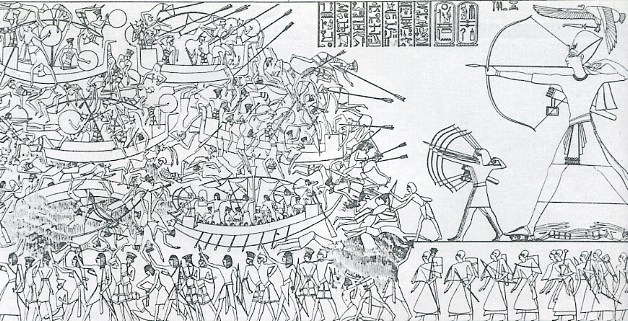
It wasn’t clear where they came from, but the Peleset, Denyen, Tjeker and other tribes descended from the north and west, destroying everything they encountered. They raided harbors, emptied treasuries and laid waste to cities, sometimes pulling the stones down, leveling the walls so survivors couldn’t rebuild.
Emissaries brought Pharaoh Ramesses III reports of the raids on his trading partners and vassals. Sometimes the raiders came by land, more often by sea. Appearing on the western horizon, giving defenders only hours to prepare. The “Sea Peoples” destroyed Ugarit, Miletus and even sacked the legendary Troy. Ammurapi, king of Urgarit, a 4,000-year old city, wrote to Pharaoh, pleading for help, “the enemy ships are already here, they have set fire to my towns and they done very great damage to the countryside.” Alas, the message, written in the hash marks of cuneiform, was never delivered, but instead found in a ruined kiln by archeologists twenty-six hundred years later.
Coming from the north and west, surviving records refer to them as the Sea Peoples because they tended to come by ship to raid Eastern Mediterranean coastal cities. Some of them wore helmets with feathers, others were distinguished by helmets with horns. Most carried round shields and prefered the sword and axe to missile weapons.
But then they left their boats and moved inland, sacking and pillaging as they went. All fell beneath the sword, including the king of Qatna, who presided over an 80-room palace, the largest of the land. And then Kadesh, a vassal of both Pharaoh and the Hittite Empire, alternately playing the two ancient superpowers against each other.
Gaining strength as they moved, the Sea Peoples then moved through Anatolia against the Hittite Empire itself. Recognizing the danger, the Hittite Emperor attempted to engage and stop the Sea Peoples by invading a neighboring kingdom to create a defense before they reached his home. But the Hittite armies were defeated and the Sea Peoples advanced to Hattusa, the legendary Hittite capital, plundering and leveling the ancient city, bringing down the once-fearsome Hittite Empire in the process.
It’s an incredible story isn’t it? All true, it happened three thousand years ago, around 1,200 B.C.E., when written records were sparse. Most of what we know comes from scattered clay tablets and a massive Egyptian temple wall carving, commissioned by Pharaoh Ramesses III, after his victories against the Sea Peoples between 1187 and 1160 B.C.E. One of the battles, probably the largest ancient sea battle ever, was recorded in great detail. But a second battle on land fought between the Sea Peoples and the Egyptians, was mostly ignored by Ramesses’ scribes. Perhaps because it was too costly a victory to celebrate, and one that was too frightful to remember.
Some added perspective: All of this happened five hundred years before Rome was founded, five hundred years before Homer composed The Illiad or The Odyssey. And yet, the pyramids at Giza had already been standing for 1,300 years.
I’ve been thinking and reading a lot recently about the ancient world as my family and I prepare for a trip to Egypt this fall. Preparing for the ancient temples and tombs, I’m trying to learn as much as I can, so I’ll appreciate everything I see on this once-in-a-lifetime trip. There’s a great deal to absorb, and so much that has happened, for millennia. We know so much about Egypt because the arid desert preserves so well and pharaohs liked to chisel their versions of history into massive stone walls. But so many other stories, of the Hittites, the Indus, the Babylonians, have been lost to time and erosion.
The stories that survived – from thousands of years ago – are sweeping, and sometimes very personal. We’re reminded by Ammurapi’s undelivered clay tablet plea that real people existed 3,200 years ago, who harbored hopes and dreams just as we do today. The distance of time and lack of written records separates us from ancient people, but it does not make us very different from them.
Historians refer to the time around 1,200 B.C.E. as the Bronze Age Collapse, where some minor climate shifts brought drought to the Eastern Mediterranean and Middle East. The weakened empires were ripe targets for the Sea Peoples, unwitting catalysts for historic change.
Archeologists believe the various tribes of the Sea Peoples eventually settled across the Eastern Mediterranean. The Peleset became known as Philistines, perhaps reviled in the Bible because their warlike ancestors had destroyed so many cities.
As I consider the Bronze Age Collapse and the Sea Peoples, I can’t help but wonder how our own history will be viewed. The American Empire’s meager 200 years is but a mere blip versus the Hittite’s 4,000 and the Egyptians’ 5,000 years. Will a predicted climate change bring a collapse of our own period? What are our monuments? What accomplishments will future archeologists wonder over?
I met a traveller from an antique land,
Who said—“Two vast and trunkless legs of stone
Stand in the desert. . . . Near them, on the sand,
Half sunk a shattered visage lies, whose frown,
And wrinkled lip, and sneer of cold command,
Tell that its sculptor well those passions read
Which yet survive, stamped on these lifeless things,
The hand that mocked them, and the heart that fed;
And on the pedestal, these words appear:
My name is Ozymandias, King of Kings;
Look on my Works, ye Mighty, and despair!
Nothing beside remains. Round the decay
Of that colossal Wreck, boundless and bare
The lone and level sands stretch far away.”